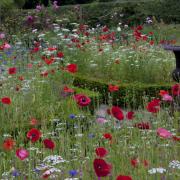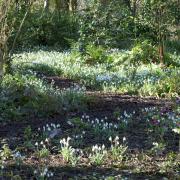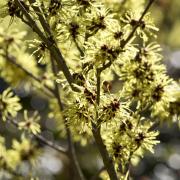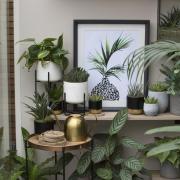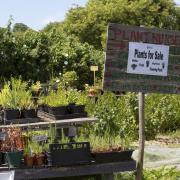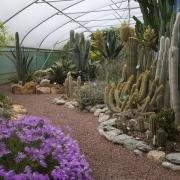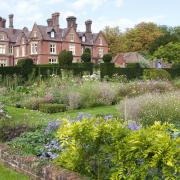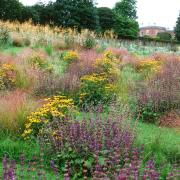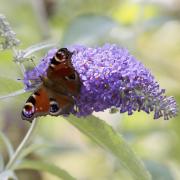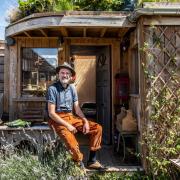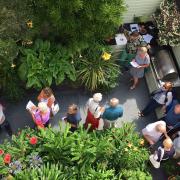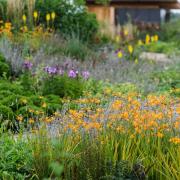Take a stroll through the garden at Tram Hatch in Charing Heath where a unique feature is the river than runs beside it

Spreading over three acres around the Grade II listed Manor House with loosely defined spaces, the gardens at Tram Hatch near Charing Heath are the creation of Pamela Scriven and her husband Allan.
Transformed from expanses of lawn, the mix of formal and informal areas are now abundantly planted with a wide palette of plants suited to each micro-climate area and the mainly alkaline soil.
“We looked at the three acres and realised we had to get involved,” says Pam. “My husband did the hard landscaping and I did the planting. The aim is to get year-round colour from a mix of flowers, shrubs and more than 100 different trees.
“Cornus, beech and acers have been planted for their beauty, long-term interest and shade. There are early snowdrops through to golden rudbeckias, dahlias and echinaceas, autumn foliage, berries and bark to admire.”

A unique feature in the garden is the ‘borrowed landscape’ of the Great River Stour (see also page 128), which runs parallel to the planting that spreads across the banks in naturalistic swathes.
“One thing we always strive to do is to make use of our natural surroundings. Although the garden does flood here, it doesn’t affect the growth,” explains Pam.
“The river enhances the garden and we have planted for that purpose with plants appropriate for the location, such as astilbes, hostas, fritillaries and marsh orchids. We have followed the concept of ‘right plant, right place’ throughout the garden.”
From the riverside area at the front of the house, the character changes in the back garden. There is a large formal rose garden, brimming with choice David Austin blooms, a dry themed grass garden, herbaceous borders, an orchard, potager, ponds fringed with plants and a much-used barbecue area.

Colour combinations are carefully considered. “I am fanatical about colours blending, matching and combining them. I have hot colours down one side of the garden and cool on the other side, an all-white garden and a blue area,” says Pam.
“Containers are important too in the arrangements, I have around 50 to plant up, and I renovate areas of the garden, as they need it. I love to walk around on my own, enjoying looking at what is in flower.”
As well as being a keen plantswoman, Pam likes to create little vignettes to draw the eye, often with decorative sculptural pieces. Some of these are made using recycled materials, such as with her son’s ironwork, a replanted black metal trough and the ‘Angel of the South’.
“Hidden away in the gardens we have sections set aside for different displays. Using statues and other centrepieces, we have attempted to create small oases of varying heritage and exotic plants and flowers to create diversity,” Pam adds.

The couple try to be as organic as possible, use no pesticides and grow everything themselves, make their own compost, around 20 tons that is distributed around the garden and especially in the veg garden, and propagate or grow from seed.
From the vast palette of plants and obvious connection with the environment, it is clear that Pam, who is self taught through research, chatting to fellow gardeners and visiting gardens, absolutely loves the garden and meets its challenges with great enthusiasm.
If a tree is damaged in a storm it offers the opportunity to change a shady fern area into a more open garden. “I redo the plantings anyhow as they change or need refurbishing. Gardening is trial and error. My parents were always keen gardeners so it has always been in the family,” she explains.
For more than a decade the couple has opened the garden for charities, including the National Garden Scheme, and also now hold events and regular yoga sessions in their new garden room. Visitors enjoy the variety of plants and areas with plenty of take-home ideas.

“What we love about opening is meeting people of like-minded interest and chatting about gardens and plants. Also making cakes, which everyone enjoys,” Pam smiles.
Get the look
• Loosely defined areas with formal or informal planting

• Colour-themed planting
• Container collections to create vignettes
• Reclaimed and recycled pieces as focal points
• Self-sufficiency and sustainable practices

• Curving borders to emulate the river banks
• Long-season interest from early bulbs to trees admired for their winter bark
• An appreciation for trees and the micro-climates they create
• Ponds to attract wildlife

• Manicured beds contrasted with naturalistic planting
Jobs to be done
• Remove spent flowers on roses, annuals and shrubs. Remember with roses to cut the stem with sharp secateurs as just breaking off the flowers may leave the plant open to infection
• Formal, evergreen hedges and topiary can be pruned now
• Shorten wisteria side shoots back to five or six leaves from the main framework
• Trim back lavender, taking care not to cut too heavily into the old wood
• Take cuttings of rosemary, fuchsias, pelargoniums and tender perennials
• You can still sow some extra salad, such as lettuces, this month. Also sow some parsley for the winter months. Plant out winter veg such as Swiss chard, oriental veg, turnips and spring cabbage
Diary note
Don’t miss the fun at Lullingstone Castle and The World Garden for the annual Plant Hunters Weekend on 26, 27 and 28 August, from 11am to 5pm
Modern-day plant hunter Tom Hart Dyke and his friends don Victorian garb and lead a guided tour of the World Garden. This year there will also be the addition of animal and reptile guests from the Second Chance Animal Rescue, so don’t be surprised if you see an Emu by the Australian plants or a Bengal cat in Asia. £10 per adult, children under 15 free.
Lullingstone Castle and The World Garden, Eynsford DA4 0JA, www.lullingstonecastle.co.uk
Tram Hatch, Charing Heath TN27 0BN
13 August (12pm-5pm) Admission £5, children free, home-made teas in the new garden room
The National Garden Scheme, www.ngs.org.uk




